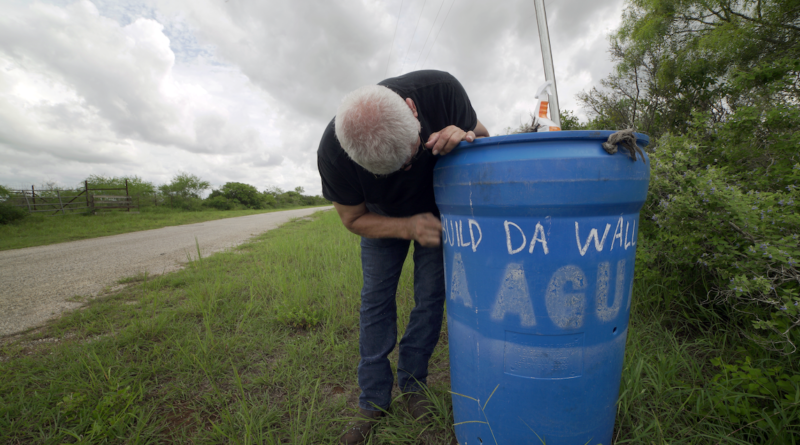REVIEW: ‘Missing in Brooks County’
Photo: Missing in Brooks County follows Eduardo Canales as he leaves water for travelers stuck in the wilds of Texas. Photo courtesy of Fork Films / Provided by MPRM with permission.
Missing in Brooks County, a new documentary from directors Lisa Molomot and Jeff Bemiss, is a harrowing account of what happens in Brooks County, Texas, to the many people coming across the border from Mexico. The authorities are set up at an immigration stop several miles from the border, so some of the travelers head into the Texan bush to work their way around the highway stop. This means they find themselves in the middle of vast ranches, beneath the blazing Texas sun, sometimes with no water or food anywhere in sight.
The film follows the many real-life dramas that surround this sad reality of people taking to the wilderness and dying under hellish conditions. There are the family members of these loved ones who set out to find answers of what may have happened in Brooks County. There are forensic scientists who try to help out by identifying and researching the many human bones that are found in the brush. There is a local humanitarian who advocates for the lost and missing, and supplies water at strategically placed locations in the backcountry. There are human smugglers, border agents and local ranchers, some of whom allow water to be stored on their property and others who do not. No matter what one might think about this issue, the people seen through the filmmakers’ lens don’t fit any preconceived notion or partisan model. Everyone involved is real and unique, and what is discovered is truly revealing.
Missing in Brooks County is a vivid, on-the-ground testimony of the current issues and debates surrounding U.S. immigration policy. During its first year in office, the Biden administration has been fending off attacks and trying to address the situation at the border, and this film provides the human context and background information for those on either side of the heated exchange. The filmmakers try to remind the audience that at the end of the day there are human lives at stake, human lives who are succumbing to the elements in this harsh terrain.
There are no politicians or great big policy speeches throughout these 81 minutes. Instead, Molomot and Bemiss focus on the efforts to address the growing humanitarian crisis in Texas. One of the protagonists is Eduardo Canales, founder of the South Texas Human Rights Center, who offers help to families searching for loved ones, and he’s also chiefly responsible for the water being distributed throughout the neighboring ranches. Through his eyes, the situation at the border comes into full focus and is brought to an individual human level, which proves effective and affecting. It’s quite enlightening and ultimately distressing to learn the facts on the ground, without the interruptions of cable news in the background.
Missing in Brooks County is necessary documentation of the humans enveloped in the dramas along the border. These are difficult stories to hear, graphic images to behold and realities that are too often sidestepped in the arena of politics. However, these narratives are important to learn from, and they provide the context that is sometimes missing from the headlines. At its heart, the film tells the story of humans struggling to survive, and those who are offering a helping hand and trying to provide answers.
By John Soltes / Publisher / John@HollywoodSoapbox.com
Missing in Brooks County (2021). Directed by Lisa Molomot and Jeff Bemiss. Running time: 81 minutes. Rating: 




